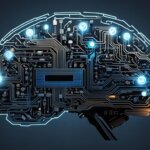Table of Contents
Welcome to our quick guide on understanding artificial intelligence (A.I.). In this comprehensive guide, we will delve into the world of A.I. and provide you with insights into its definition, advancements, and applications. Whether you’re new to the concept or looking to expand your knowledge, this guide will equip you with a solid foundation in A.I. and its relevance in today’s world.
Artificial intelligence, often referred to as A.I., is a rapidly evolving technology that has permeated various aspects of our lives. From driverless cars to medical image analysis, A.I. has revolutionized industries and transformed the way we interact with technology. By understanding the fundamentals of A.I., you’ll be able to better comprehend its implications and harness its potential.
In this guide, we will explore the origins of A.I., delve into its different types, and examine how A.I. works. We will also take a closer look at its wide-ranging applications and discuss the future of this groundbreaking technology. By the end of this guide, you’ll gain a comprehensive understanding of A.I. and its impact on our everyday lives.
So, whether you’re a curious individual or a professional seeking in-depth knowledge about A.I., our guide will provide you with the necessary insights and answers. Let’s embark on this journey of understanding A.I. together!
The Origins of Artificial Intelligence
The term “artificial intelligence” was first coined by Dartmouth professor John McCarthy in 1956 during the Dartmouth Summer Research Project on Artificial Intelligence. The goal of the project was to explore how machines can use language and perform tasks like humans. While the initial hopes for AI were high, the results fell short of expectations. However, the workshop laid the foundation for AI as an academic field. Early AI research focused on solving abstract mathematical problems but eventually started showing promise in more human-like tasks. This led to breakthroughs in areas like game-playing, image recognition, and speech recognition.
| Year | Event |
|---|---|
| 1956 | Dartmouth Summer Research Project on Artificial Intelligence |
| 1961 | General Problem Solver (GPS) developed |
| 1974 | First AI system capable of understanding and generating natural language |
| 1997 | IBM’s Deep Blue defeats world chess champion Garry Kasparov |
| 2011 | IBM’s Watson wins on Jeopardy! |
| 2016 | AlphaGo defeats world champion Go player Lee Sedol |
John McCarthy, the Dartmouth professor who coined the term “artificial intelligence”
Despite early setbacks, AI research continued to progress, and today we have AI systems that can outperform humans in specific tasks. From natural language processing to computer vision, AI has permeated various aspects of our lives and industries. The origins of AI can be traced back to the Dartmouth Summer Research Project, which paved the way for the development of this transformative technology.
Types of Artificial Intelligence
In the world of artificial intelligence, there are various types of AI, each with its own unique capabilities. Let’s explore the different categories:
Narrow AI or Weak AI
Narrow AI, also known as Weak AI, is designed to perform specific tasks and functions. This type of AI is commonly used in applications like image recognition, speech recognition, and recommendation systems. Narrow AI excels in its designated area, but it lacks the ability to generalize and transfer knowledge to other domains. It operates within predefined boundaries and does not possess human-like intelligence.
General AI or Strong AI
General AI, or Strong AI, aims to replicate human-level intelligence and perform a wide range of tasks across different domains. This type of AI possesses the ability to learn, reason, and apply knowledge to various situations, just like a human being. General AI would be capable of understanding and learning from any given task, exhibiting flexibility and adaptability. However, achieving General AI is still an ongoing research area and remains a significant challenge.
Super AI or Artificial Superintelligence
Super AI, also known as Artificial Superintelligence (ASI), surpasses human intelligence and has the potential to solve complex problems beyond human capabilities. This type of AI excels in cognitive tasks and could potentially outperform humans in various fields. Super AI represents a hypothetical level of AI that exceeds the intelligence of the brightest human minds. The development of Super AI poses significant ethical and safety considerations, and its realization remains uncertain.
https://www.youtube.com/watch?v=cVjq53TKKUU
In the current landscape, Narrow AI is the most prevalent form of AI, widely used in practical applications. However, researchers and scientists are continually striving to achieve General AI and exploring the possibilities of Super AI in the future.
| Type of AI | Description |
|---|---|
| Narrow AI or Weak AI | Designed for specific tasks, lacks general intelligence |
| General AI or Strong AI | Aims to replicate human-level intelligence across domains |
| Super AI or Artificial Superintelligence | Surpasses human intelligence and tackles complex problems |
How AI Works
Artificial Intelligence (AI) is powered by the processing of large amounts of data and the implementation of complex algorithms. One of the key components of AI is machine learning, a technique that enables computers to learn from vast datasets and recognize patterns to make informed predictions.
There are different types of machine learning, each serving a unique purpose. Supervised learning involves training the computer on labeled examples, allowing it to understand the relationships between inputs and outputs. This type of machine learning is commonly used in tasks like image recognition and language translation.
In contrast, unsupervised learning enables the computer to identify patterns in unlabeled data without any predefined categories or labels. This approach is ideal for tasks like clustering or uncovering hidden structures in data. Researchers have also developed reinforcement learning, where the computer learns through trial and error to maximize rewards while interacting with its environment.
Machine learning gives computers the ability to learn and improve without being explicitly programmed. It is a fundamental concept in the field of AI and has unlocked a world of possibilities.”
Another critical aspect of AI is the use of large language models. These models enable AI systems to understand and comprehend language, opening up a wide range of applications in natural language processing, chatbots, and virtual assistants. Large language models like OpenAI’s GPT-3 have revolutionized the way AI interacts with human language, providing more natural and contextually relevant responses.
Types of Machine Learning
| Type | Description | Example |
|---|---|---|
| Supervised Learning | Training on labeled examples to recognize patterns and make predictions | Image classification |
| Unsupervised Learning | Identifying patterns in unlabeled data without predefined categories | Market segmentation |
| Reinforcement Learning | Learning through trial and error to maximize rewards | Game-playing AI |
By combining these machine learning techniques with vast amounts of data and powerful algorithms, AI systems can perform complex tasks, make accurate predictions, and continually improve their performance over time.

Applications of AI
Artificial Intelligence (AI) has significantly transformed various industries and is increasingly becoming a part of our everyday lives. From healthcare to transportation, finance to agriculture, AI’s applications are diverse and expanding. Let’s explore some of the key domains where AI is making a significant impact.
1. AI in Healthcare
In the field of healthcare, AI is revolutionizing the way medical professionals diagnose diseases and develop treatment plans. AI-powered systems are capable of analyzing medical images with great precision, aiding in early detection of conditions. Additionally, AI algorithms can process vast amounts of medical data, helping doctors identify patterns and make accurate diagnoses.
Moreover, AI is accelerating drug discovery processes by analyzing genetic data and predicting the effectiveness of potential drug compounds. This has the potential to speed up the development of life-saving medications and therapies.
2. AI in Transportation
The advancements in AI have paved the way for self-driving cars and improved traffic management systems. AI algorithms enable autonomous vehicles to perceive their surroundings and make real-time decisions, enhancing road safety and reducing accidents caused by human error.
Furthermore, AI is being utilized in logistics and supply chain management, optimizing routes and streamlining operations. This not only ensures efficient movement of goods but also reduces fuel consumption and carbon emissions, contributing to a more sustainable transportation system.
3. AI in Virtual Assistants
Virtual assistants such as Siri, Alexa, and Google Assistant have become an integral part of our daily lives. These AI-powered digital companions leverage natural language processing and machine learning algorithms to understand user queries and provide relevant information or perform tasks. From setting reminders to playing music, virtual assistants offer convenience and efficiency.
4. AI in Finance
In the financial industry, AI is instrumental in fraud detection, risk analysis, and investment recommendations. AI algorithms analyze vast amounts of data, identifying patterns of fraudulent activities and mitigating potential financial threats.
Additionally, AI-driven trading systems leverage machine learning algorithms to predict market trends and make informed investment decisions. This enables financial institutions and investors to optimize their portfolios and maximize returns.
5. AI in Other Sectors
Apart from healthcare, transportation, and finance, AI is making significant contributions to various other sectors. In agriculture, AI-powered drones and sensors monitor crops, soil conditions, and weather patterns, enabling farmers to make data-driven decisions and optimize crop yields.
Cybersecurity systems employ AI algorithms to detect and prevent cyber threats, identifying patterns of malicious activities and safeguarding sensitive data.
| Industry | Application |
|---|---|
| Healthcare | Medical image analysis, disease diagnosis, drug discovery |
| Transportation | Self-driving cars, traffic management |
| Virtual Assistants | Understand and respond to user queries |
| Finance | Fraud detection, risk analysis, investment recommendations |
| Agriculture | Crop monitoring, data-driven decision making |
| Cybersecurity | Threat detection, data protection |
As technology continues to advance, the potential applications of AI are limitless. From improving healthcare outcomes to transforming industries, AI is reshaping our world, offering innovative solutions and paving the way for a future driven by intelligent machines.
The Future of AI
The future of artificial intelligence (AI) is poised for remarkable advancements. With ongoing progress in hardware and training techniques, AI capabilities are set to reach new heights. This will fuel innovation and efficiency across various sectors as businesses and industries increasingly integrate AI into their operations.
However, as AI continues to evolve, it is crucial to address the ethical and social implications that come with its rapid development. Responsible and ethical use of AI is of paramount importance in order to maximize its benefits and mitigate any potential risks.
Efforts should be made to ensure that AI technologies are developed and deployed with a strong emphasis on accountability, transparency, and fairness. Continued research, collaboration, and regulation will play pivotal roles in shaping the future of AI and fostering its responsible integration into our society.
FAQ
What is artificial intelligence (AI)?
Artificial intelligence (AI) is a rapidly advancing technology that allows computers to learn from examples and perform tasks that would traditionally require human intelligence. It encompasses various applications such as image recognition, speech recognition, and virtual assistants.
What are the origins of artificial intelligence?
The term “artificial intelligence” was coined in 1956 during the Dartmouth Summer Research Project on Artificial Intelligence. While the initial results fell short of expectations, the workshop marked a significant milestone in the development of AI as an academic field and laid the foundation for future breakthroughs.
What are the different types of artificial intelligence?
There are different types of artificial intelligence. Narrow or weak AI refers to AI systems designed for specific tasks, while general or strong AI aims to replicate human-level intelligence across various domains. Super AI goes beyond human capabilities and can potentially solve complex problems.
How does AI work?
AI works by processing large amounts of data and using algorithms to learn and make predictions. Machine learning, a key component of AI, involves training computers on datasets to recognize patterns and make decisions. Additionally, large language models enable AI systems to process and understand language.
What are the applications of AI?
AI has a wide range of applications across various industries. It is used in healthcare for medical image analysis, disease diagnosis, and drug discovery. In transportation, AI powers self-driving cars and improves traffic management. AI also plays a role in finance, cybersecurity, agriculture, and many other sectors.
What does the future hold for AI?
The future of AI is filled with excitement and challenges. Advancements in hardware and training techniques are expected to enhance AI capabilities further. However, there are also concerns about the ethical and social implications of AI. Responsible and ethical use of AI, along with continued research and regulation, will shape its future integration into society.







